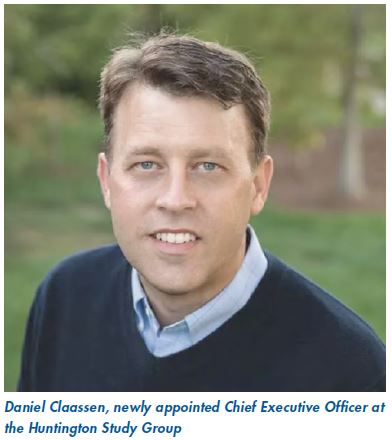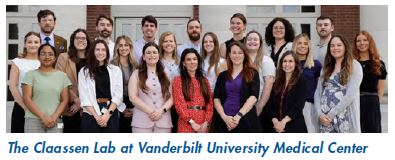
Interview with Daniel Claassen, Chief Executive Officer at the Huntington Study Group
Highlight from the: EHDN Newsletter_July2025_Issue55
Professor of Neurology and Division Chief of Behavioral and Cognitive Neurology at Vanderbilt University Medical Center, Daniel Claassen, is an internationally recognised clinical researcher in HD. In 2012, he founded the renowned Huntington’s Disease Society of America Level 1 Center of Excellence at Vanderbilt. In September 2024, he took up the position of Chief Executive Officer at the Huntington Study Group (HSG). We were excited to find out more about this exciting development for the HD community and ask Daniel about his mission and aspirations for HSG and HD care.

What motivated you to establish the Center of Excellence at Vanderbilt University Medical Center?
I came to Vanderbilt in 2011, having completed my medical residency and fellowship training, as well as gaining academic experience and a dedication to working in HD at the University of Virginia. I had come to see that HD is a very dynamic disease encompassing motor, cognitive, psychiatric, and social issues. I was also fascinated by the concept that HD is treatable from the standpoint of symptoms. I was approached by several people, one of whom was the father of a person with HD and also a clinician at Vanderbilt who said that we really need to have an HD programme here – would you lead it? I said I’d love to. We started small, with between 50 and 100 patients attending the neurology clinic. We then added nursing, psychology, and social work provision, and now provide a fully multidisciplinary service. Over the years, the clinic has continued to expand, and we now have over 500 families.
One of the significant drivers of momentum in the clinic was the presence of clinical trials and the opportunities for people with HD to participate in clinical research. I realised early on that it’s very important for people with HD to have the opportunity to participate in research – not only for themselves but also for their children and the broader community.
How did you get involved with the HSG?
One of my first experiences with HSG was through a trial conducted at Vanderbilt on deutetrabenazine (Austedo), and I also started to attend HSG annual meetings. We conducted several additional trials with the HSG and led some of the imaging analysis efforts for various trials. I was given the opportunity to serve as a co-principal investigator on the KINECT-HD trial by Neurocrine Biosciences, which further solidified my alignment with HSG.
One of the things that is really important about the HSG is the people who are part of it. It’s a very close-knit commu-nity of like-minded folks who work with people impacted by HD. It was quite a surprise when the opportunity to become further involved in HSG came up! I received phone calls from a couple of people, including Andy Feigin, one of the former Chief Medical Officers, who informed me about potential leadership opportunities. It seemed a great opportunity, and a timely one, given that I had really enjoyed setting up and developing the clinic at Vanderbilt, and I was already thinking about how I could use this experience to help others grow their own clinics. It is fundamentally important for me to improve access to clinics for people with HD as well as to increase community engagement.
What activities have you been working on so far?
There are four main areas in which we are making progress at HSG. The first is education, and in particular, ensuring that we nurture the development of our future generations of HD researchers and clinicians. We have some great people dedicated to initiatives like ENGAGE-HD, which gets neurology trainees involved in HD care through a range of learning options. The second focus is on the clinical aspects of HD. How do we treat, say, juvenile HD or deal with antipsychotic use? We want to develop consensus on key questions to better inform and support clinical practice. The third focus is on scientific advice. In the United States, we are often called upon to sit on scientific advisory committees, for example, and I believe we can leverage the expertise of HSG scientists to provide this more rigorously. Finally, we are examining site development, particularly ways of preparing upcoming clinicians and researchers for the administrative and business challenges that aren’t taught in medical school.
| ‘I realised early on that it’s very important for people with HD to have the opportunity to participate in research – not only for them- selves but also for their children and the broader community.’ Daniel Claassen |
We’ve developed a new governance model that will facilitate the progression of these four key topics through advisory councils. The chair of each advisory council will also be involved in a newly established executive committee. We have just announced the results of an election for the chair of the executive committee, which featured three incredible candidates: Danny Bega, Katherine McDonell, and Erin Furr-Stimming. Erin will be taking up the position and I look forward to working with her. We’re seeing great engagement, which is encouraging because it shows that people care, want to be involved, and support the democratic governance structure of HSG.
What critical challenges facing HD care will HSG address?
There are numerous challenges, but one that I think we really need to address is developing a care model for HD that focuses not only on symptomatic individuals but also on aspects such as brain health. In Alzheimer’s disease, for example, people often ask, ‘What can I do to keep my brain healthy?’ and they visit brain health clinics to discuss topics such as cholesterol and exercise. Unfortunately, our clinics aren’t currently set up for that, and the interdisciplinary care model in HD implies that there are obvious clinical symptoms that require treatment. One of the big challenges for HSG is helping clinics reposition themselves to support people who are at-risk or gene-positive much earlier. If we do that, we can let these people know about trials sooner, meaning that we will get much-needed answers more quickly.

What are the synergies between HSG and EHDN?
One of the joys I experience as a physician working in HD is meeting people from diverse locations and backgrounds. I have always enjoyed attending the EHDN plenary meetings, and in my new role at HSG, I was eager to speak with Patrick Weydt and Jamie Levey about their strategies at EHDN. It’s been really helpful because EHDN does a lot of things really well and has an excel-lent support system.
We’re now focusing on how working groups between the two organisations can share ideas. We believe this is a really good first step because we share many of the same challenges on both sides of the Atlantic. Patrick and I are keen to develop unified initiatives, progress towards finding better treatments, and address some of the complex issues in HD research and care.
| ‘The HD field is unique while presenting numerous opportunities for collaboration with others, both in research and clinical care.’ Daniel Claassen |
What would be your advice for early-career clinicians and researchers who want to help improve the lives of those impacted by HD?
I believe the most important aspects are collaboration and effective communication with colleagues. Every site, clinic, and administrator is different, but when you get to talk about how people are doing things, you get to learn about what’s working and what’s not working, and incorporate it into your own vision. I’ve never met an HD clinician who isn’t willing to collaborate or be engaged in mentoring. The HD field is unique while presenting numerous opportunities for collaboration with others, both in research and clinical care. Taking up opportunities offered by organisations such as HSG and EHDN is also a valuable step forward in this direction.

